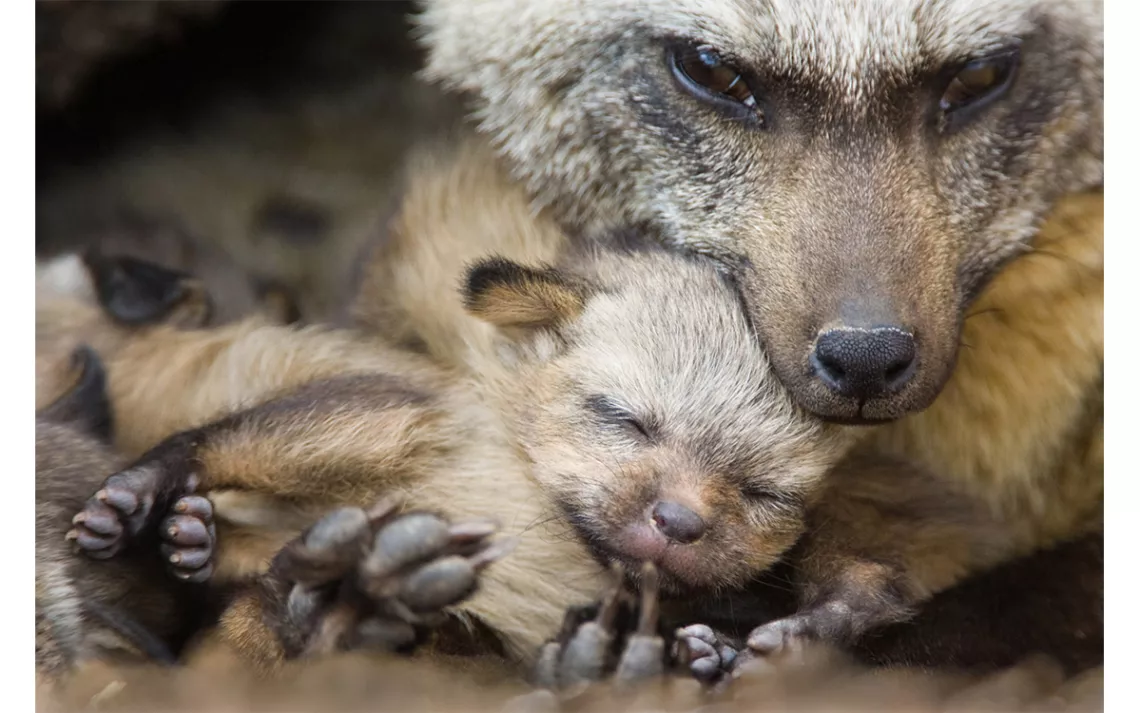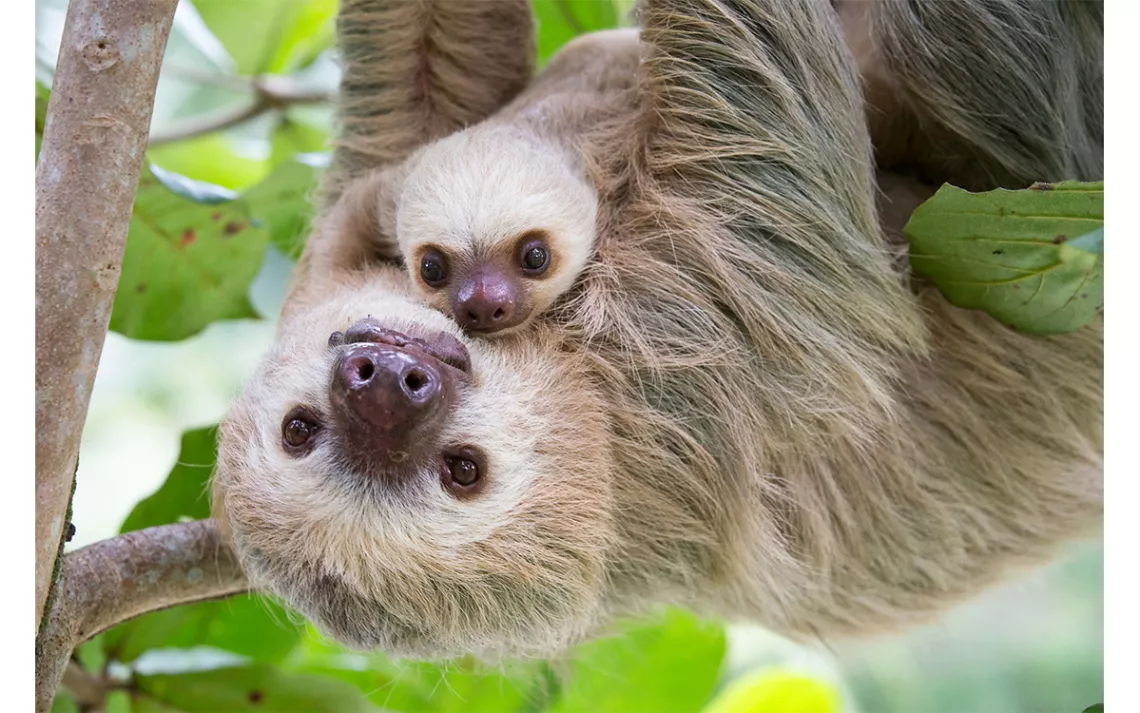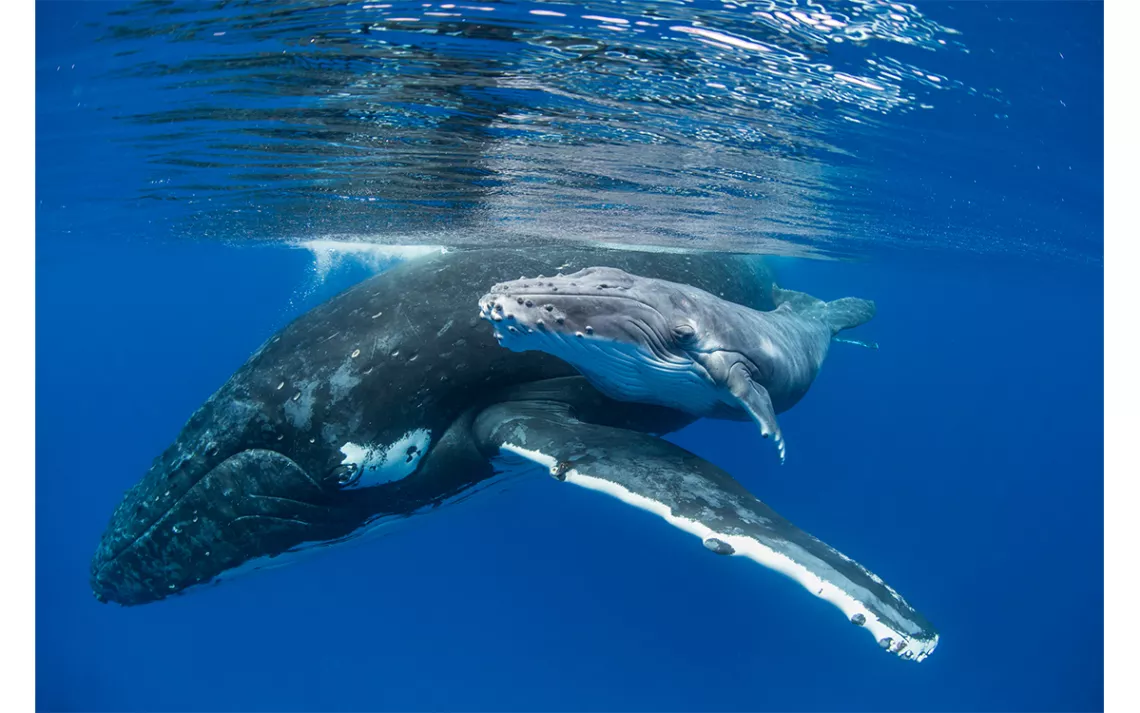Where Baby Animals, Sisterhood, and Conservation Collide
Wildlife photography is dominated by men. Suzi Eszterhas wants to change that.
Photos by Suzi Eszterhas
Suzi Eszterhas has spent her career capturing the cutest baby animals you’ve ever seen. She’s published 14 books and over 100 magazine cover and feature stories for publications like Time, Smithsonian, and National Geographic Kids. Eszterhas, who won a prestigious award in the Wildlife Photographer of the Year competition, and was named Environmental Photographer of the Year, among other accolades, uses her images to raise money for wildlife causes including protection for orangutans, cheetahs, tigers, and sloths.
Now, along with decades of conservation work, she’s started a new mission: to bring more women into her male-dominated field.
In 2017, Eszterhas began Girls Who Click, a series of free nature-photography workshops for teen girls. She hopes participants will feel empowered to use photography to make a difference, including to further the work of conservationists.
Eszterhas spoke to Sierra about her lifelong love of wildlife, a new mission on behalf of girls, work as a place of joy, and how she refuses to give up hope in her fight for conservation.
*
Sierra: You publish a lot of your work, including in books and magazines, for a younger audience. As a child, what drew you to the combination of wildlife and photography?
Suzi Eszterhas: I was a kid who was incredibly obsessed with wildlife, so I always knew I wanted to be a wildlife photographer. I was drawn to the domestic animals we had as pets but also to the wild animals that lived in the backyard. I spent a lot of time after school watching and photographing birds and squirrels. I took painstakingly detailed field notes of their behavior. I watched wildlife documentaries, and I used to tear animal pictures out of magazines and plaster them on my walls. It was very much the center of my being from a very, very young age.
My connection [to wildlife] fostered a deep commitment to helping the planet. I think the biggest crisis on the planet is that our children are so disconnected. How do we get our kids outside and get them connected to nature? It’s absolutely critical in conservation. I work with a lot of adult readership magazines, but I care most about the kids. I have an online print shop specializing in nursery-room prints because, if from a young age, we can bombard them with photographs of nature and animals, it’s the next best thing to putting them outside.

Cheetah

Suzi Eszterhas
Your nonprofit, Girls Who Click, offers free nature-photography workshops to teenage girls. What was your inspiration for starting this organization?
It was definitely to get teenagers outside. When we talk about connecting kids to nature, you want to try as young as you can. But for me, the teen years were hard. I lost my center and lost my focus. So the workshops are also empowering them and letting them know you can have a career in nature. A lot of teenagers are in a really formative place. We want to let them know they don’t have to give up on a dream like this.
Photographers are always great observers, and that’s the other thing that's nice—a lot of these workshops are about sharing. We’ll see our girls at the end of the day looking at the back of the camera sharing their imagery with each other. They usually don’t have a friend in the workshop, so they’ll start the day by being quiet and shy. They’re way out of their comfort zone; we’ll get girls who haven’t spent a lot of time in nature. But by the end of the day, they’re down in the dirt right there with you. Confidence is huge, particularly with teen girls. We don’t just teach photography. We try to be good role models and strong women. Strong is the new sexy. We’re trying to impart that strength on our girls.
Can you take us through that day? What might it be like for future girls interested in your workshop?
We usually start with a classroom presentation, and then we will take them out into the field. We instruct them on how to take photos and also what to look for. Sometimes a landscape can be overwhelming, but it’s about looking down at your feet and noticing the beautiful patterns on the leaves and the bark on the tree. It doesn’t have to be these species of megafauna. My workshops are pretty easy because we see sea otters and sea lions but not every Girls Who Click workshop has wildlife. I lead mine at a gorgeous place in Monterey, California, called Little Serengeti. The sea otters aren’t shy with the boat so they’ll go right alongside us.
But Girls Who Click isn’t just me. It’s a network now of myself and my female colleagues. I took the model of what I do in Monterey, and I asked my female colleagues, “Would you be willing to do the same thing in Virginia? In Oregon?” And they’re doing it for free. No one’s getting paid. Everything's donated. We’ve never even had to pay for a venue. When I started this in Monterey, I was so touched because once the boat rental company found out what I was doing, they were like, you’re not paying for this.
Before I started my nonprofit, I ran a few of these workshops as a service to the community. I wanted to do something to combat the lack of women in a male-dominated career. I thought these workshops might make a little bit of a difference. But what I wasn't really prepared for is how much they inspired me. I was pretty confident the girls would be moved. But I was not prepared for how much it would mean to me.
How are you hoping Girls Who Click might help diversify the field of photography?
Nature photography lacks diversity like very few professions these days. It’s a very expensive profession to take on, so for a lot of people it’s not even on their radar. For example, [before going full-time] I did initially have a day job and I had an extraordinary amount of debt trying to get into the gear and travel. I carried around $50,000 in debt for 12 years. Nature photography doesn’t just need diversity in terms of women but also in terms of cultural background and income status.
In our workshops, we always have two low-income positions for girls. We partner with Borrow Lenses, and they sponsor camera rental gear. I believe really strongly in trying to reach lower-income girls, and I hope that we’ll see a new wave of young female nature photographers entering the profession. I hope we’re going to get more girls outside with or without a camera.

Girls Who Click | Photo courtesy of Amber Hockerborne
You’ve described nature photography as a pretty male-dominated field. How did you muscle your way into that arena?
In the beginning, I didn’t really think about it. I was just doing my thing. I started noticing there wasn’t a lot of women in this career when I went to conferences and saw all the professionals were men. But it’s not something that really registered until I was treated differently. The struggles I’ve had have been across the board. It’s everything from patronizing attitudes to people not taking me seriously to downright sexual harassment and scary moments in the field. You sort of experience these things, and you get used to it; when I was young, I was even more driven, so I tended to just ignore it or if I had to deal with it I wasn't afraid of conflict. I just tried to keep plowing ahead.
It’s not easy to be a minority in any field, but wildlife photography is particularly male-dominated. When I started my nonprofit, we found a lot of parallels to it in STEM careers. For example, there’s more women than men who are majoring in STEM careers at the university level, but in the crossover from studying it to doing it professionally, that ratio gets completely skewed toward men. And that’s exactly how it is with wildlife photography. There are a lot of female nature photographers that do this as a hobby, but there’s very few who do this for a living. It’s changing now with the younger generations, but it’s still very male-dominated.
A few years ago, I reached a point in my life where I was doing a lot for conservation, but I kind of wanted to do something more for my fellow human beings and especially young people. I saw this as something that really needed to change. Because, again, there's no reason why it’s male-dominated. This is a field that gives people a tremendous amount of joy. I mean, I can’t tell you the joy this job has given me, and there’s no reason women can’t experience that joy just as much as men.
Wildlife photography seems like a very exploratory field—you’re on the move and seeing new things all the time. Can you talk about where you think the joy you describe comes from?
It’s important to note that not all my days are in the field. I do have to spend days at my desk, and it’s just as boring as any other day for any other job at a desk. I think of my days in the field as really big days. And they’re all completely different from each other. There is no day in nature that is just like the day before. And this becomes incredibly obvious on some of my projects—one of the things I specialize in is den work with specific females and their young. I might follow a mother for weeks or months or more.
People also tend to romanticize this career. They think it’s a super sexy career, but there’s nothing sexy about it. Yes, you get to travel the world and see these beautiful animals, but most of the time you’re really hot or really cold, and surrounded by insects. You also have to schlep a ton of really heavy gear all over the world and go trekking with it all on your back. It’s a dirty job. It’s a tough job. There are some misconceptions, but overall it is an absolutely joy-filled career. Part of the joy is how hard you work for it. You’ve earned it.
I just got off a leopard den project. I did five different trips to Botswana. And I started from the time when they were five weeks to 16 months and right on the cusp of independence. One day you spent with the cubs could be nonstop drama. And the next day you’re at the den site staring at a termite mound and nothing happens for 14 hours. You just don’t know what to expect, and that’s the exciting thing. The other thing about having time in the field is that nature is an incredibly healing and calm place to be. If you spend enough time in nature, you will become deeply present. It’s another thing that contributes to that joy.
Like you mentioned, many of your photos document the relationships between adults and offspring, often showing a comfortable or playful side of big animals like lions, tigers, and polar bears. Why did you decide to focus on these aspects of den life?
I have this mindset in life of doing what you love, and as a photographer, to shoot what you love, because if you’re passionate about your subjects it’s most likely going to be your best work. I gravitated toward baby animals because of their innocence and their vulnerability. There’s not a lot of room for either in our culture. When we see these moments that capture that emotion, it sort of opens your heart a little. It softens your heart. And that’s what I thrive on. That’s what cute does. I hope it’ll open up hardened hearts and make a difference in how people think about these animals. Sadly, as we lose more and more animals on this earth, so many of the species I photograph—we’re counting them. So every new life is incredibly precious in terms of the species survival.
In your long career, what are you most proud of?
One of the things I’m most proud of is how I’ve used my images to raise money for various causes. And I’m proud of how hard I’ve worked, and the time and energy put into these projects. The leopard den project was three years in the making. But I’m also constantly humbled by my subjects. They’re incredible creatures. I try not to get too doom and gloom about what’s going on, but these are incredible beings and we’re losing them at rapid rates. I was recently putting together a collection of the species I’ve worked on, and so many are now endangered or threatened, and their status has changed in the last 20 years I’ve been in the business. Conservationists are really struggling because it can be so demoralizing.
But there’s so much [research] now on conservation optimism and how important it is. I’m quite a hopeful person, and my imagery of new life on this earth is a hopeful thing. Some people get really hopeless in this career, and I refuse to think this way. I don't have children, but I refuse to be hopeless just for their sake.
 The Magazine of The Sierra Club
The Magazine of The Sierra Club












